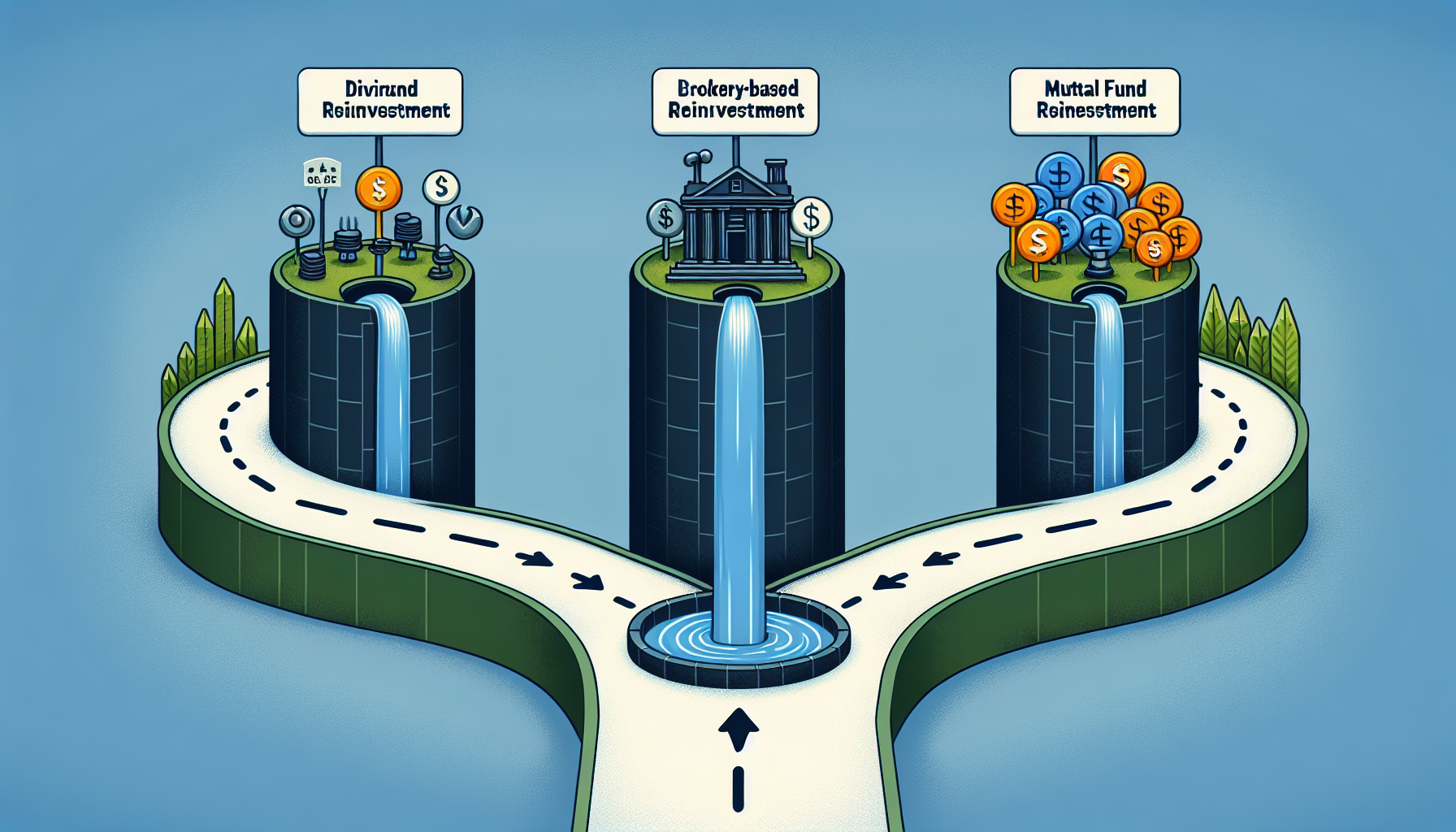Ever wondered what could significantly boost your long-term wealth accumulation? Dividends, the oft-ignored part of an investment portfolio, may be the secret ingredient. But what if there was a way to make these dividends work even harder for you? Enter the world of thee types of dividend reinvestment, a method that could incrementally increase your wealth over time.
Disclaimer: This information is general in nature and for informational purposes only. It is not personal financial advice and has not taken into account your personal financial position or objectives. Make sure to refer to a licensed financial or tax advisor.
Table of Contents
Key Takeaways
- Dividend reinvestment amplifies long-term returns by using company-issued cash dividends to automatically acquire additional shares, leveraging the power of compounding and thus benefiting from stock price increases and dividend growth.
- Investors can reinvest dividends through Dividend Reinvestment Plans (DRIPs) directly with companies, brokerage-based reinvestment programs that allow fractional share purchasing, or mutual fund/ETF reinvestment plans for added diversification.
- Reinvested dividends are subject to taxes as income in the year they are received, which can include capital gains taxes, and investors should consider tax-advantaged accounts and strategies to minimize the tax burden.
Understanding Dividend Reinvestment
Dividends are periodic payments distributed by a company to its shareholders. These dividend payments are often a distribution of the company’s profits, typically given out on a quarterly basis. Now, what if, instead of spending these dividends, you reinvest them back into the investment? This process of channeling the dividend payment back into acquiring additional shares, rather than using them for other purposes, is known as dividend reinvestment.
The attraction of dividend reinvestment stems from the compounding power. When you reinvest your dividends, you buy more shares, which in turn generate their own dividends, leading to a cycle of compounded dividends. This cycle can supercharge your investment’s growth, leading to increased wealth over time.
For instance, if you had initially invested $20,000 in a dividend paying stock at $20 per share, and the company pays a dividend of $2 per share that increases by $0.25 a year, and the stock price increases by 10% yearly. After three years, your original 1,000-share investment would have grown to 1,304 shares, and the value would have increased from $20,000 to $34,721—a 73% increase.
What is Dividend Reinvestment?
Dividend reinvestment is the practice of using dividends generated from an investment to acquire further shares of the same investment. This process enables investors to automatically increase their holdings of the company’s stock when the company pays dividends. Such a strategy can be implemented through a Dividend Reinvestment Plan (DRIP) provided either directly by the issuing company or through brokerage programs.
The allure of reinvesting dividends is the opportunity to amplify long-term returns through the snowball effect of compounding. When the dividend doesn’t meet the cost of a full share, fractional shares are allocated to the investor, ensuring that all dividend income is utilized for the purchase of shares, even when the dividends paid are not enough to cover the cost of a full share. This aspect of reinvesting dividends offers the potential to gradually acquire more shares over time, using the power of dollar-cost averaging to your advantage.
Benefits of Dividend Reinvestment

Dividend reinvestment can substantially magnify your investment’s value over time. By channeling the dividends back into the purchase of more shares, you are essentially adding to your original investment without spending any additional money. This strategy is especially effective when the company’s stock price is rising, as the reinvested dividends help to exponentially increase the value of your investment.
Another notable benefit of dividend reinvestment is the potential to purchase shares at a discounted rate. Some dividend reinvestment plans allow investors to acquire additional shares at a price lower than the market rate, thus increasing the value of each reinvested dividend and expediting the growth of their investment. Furthermore, the allocation of fractional shares ensures that all dividends, regardless of their size, contribute to the growth of the investor’s holdings.
Three Types of Dividend Reinvestment

Armed with an understanding of the concept and benefits of dividend reinvestment, we can now explore the three primary types of dividend reinvestment: Dividend Reinvestment Plans (DRIPs), brokerage-based reinvestment, and mutual fund/ETF reinvestment.
A Dividend Reinvestment Plan (DRIP) is a program provided by a company to its shareholders, enabling them to reinvest their cash dividends into additional shares of the company’s stock automatically, often at a discounted rate. This facilitates the gradual growth of a shareholder’s ownership stake, leveraging the power of compounding.
Brokerage or investment company-based dividend reinvestment is a service offered by brokerage firms, enabling investors to automatically reinvest dividends from stock holdings into additional shares, thereby facilitating the expansion of their investment in a specific stock.
Mutual fund and ETF dividend reinvestment plans allow investors to benefit from automatic dividend reinvestment, as their received dividends and capital gains distributions are automatically reinvested into more shares of the fund or ETF. This promotes growth in their holdings without the need for additional action or fees, and can ultimately pay dividends in the long run.
Dividend Reinvestment Plans (DRIPs)
Dividend Reinvestment Plans, or DRIPs, are offered by companies to automatically reinvest dividends into additional shares. Here are some benefits of DRIPs:
- Dividends are reinvested automatically, eliminating the need for manual reinvestment.
- DRIPs often offer shares at a discount, allowing investors to buy more shares for their dividend income.
- DRIPs typically have no transaction fees, saving investors money.
- DRIPs provide an automatic, hands-off approach to maximizing investment returns.
Investors can establish a DRIP with a company by enrolling through their brokerage firm at the time of purchasing an investment online. While DRIPs provide the benefit of accumulating more shares without incurring a commission and leveraging dollar-cost averaging, a potential drawback is the limited ability to execute sell or buy orders as swiftly as with a standard brokerage account.
Companies such as Aflac Incorporated (AFL), Abbott Laboratories (ABT), AbbVie Inc. (ABBV), and Chevron Corporation, among others, offer Dividend Reinvestment Plans (DRIPs).
Brokerage-Based Dividend Reinvestment
Brokerage-based dividend reinvestment provides investors with flexibility and control over their investment strategy. Through this method, investors can opt to participate in their broker’s DRIP program for automatic reinvestment, or they can elect to manually place a buy order using the cash dividend distributed to their account.
Brokers such as Robinhood, Interactive Brokers IBKR Lite, E*TRADE, J.P. Morgan Self-Directed Investing, M1 Finance, TD Ameritrade, Charles Schwab, Fidelity Investments, and Firstrade provide plans for dividend reinvestment. This type of reinvestment offers the opportunity to acquire fractional shares, consistently reinvest dividends, and obtain new shares or stocks without incurring brokerage fees or commissions.
Mutual Fund and ETF Dividend Reinvestment
Mutual Fund and ETF dividend reinvestment is another viable option for investors. This method involves utilizing dividend income to acquire additional shares of the fund or ETF, offering diversification and ease of management.
When dividends are reinvested in mutual funds and ETFs, the cash is utilized to purchase additional shares, thereby expanding the investor’s position in the fund. Dividend reinvestment can be arranged with a broker or fund company, enabling the compounding of investments over time and potentially enhancing returns. The benefits of this method encompass:
- Accelerated investment growth
- Enhanced overall returns
- Increased income generation through the purchase of additional shares
- Long-term wealth accumulation.
Tax Implications of Dividend Reinvestment
Despite the enticing wealth-compounding potential of dividend reinvestment, awareness of the tax implications is crucial. Reinvested dividends are indeed subject to taxes, irrespective of the method of reinvestment, such as DRIPs or other forms. This means that even if you’re not seeing the dividends in your bank account, you’re still required to pay taxes on them as they’re considered income.
The tax implications don’t end there. Dividends that are reinvested through DRIPs will still be subject to capital gains taxes, just like dividends that are not reinvested. This means that the tax treatment remains the same regardless of whether the dividends are reinvested or not. Moreover, the tax rates for dividends can differ based on their classification. Qualified dividends are subject to taxation at the same rate as long-term capital gains, often lower than the tax rate for unqualified dividends, which are taxed at the ordinary income tax rate.
Unfortunately, reinvesting dividends does not provide a means for investors to evade tax payments. Dividends are considered taxable income in the year they are received, irrespective of whether they are received as cash or reinvested. So, while reinvesting dividends can be a powerful strategy for wealth accumulation, it is essential to account for tax implications in your overall investment strategy.
Tax Rates for Reinvested Dividends
In terms of tax treatment, it’s important to realize that reinvested dividends are indeed taxable, as they qualify as taxable income, irrespective of their reinvestment or cash receipt. The tax rates for these dividends can vary.
Qualified dividends, which are dividends that meet certain requirements, are subject to tax rates of 0%, 15%, or 20%, which are determined based on the investor’s taxable income and filing status. On the other hand, non-qualified dividends, which don’t meet these requirements, are subject to taxation at rates that can go up to 37%, representing a substantial increase compared to the taxation of qualified dividends.
Strategies for Minimizing Taxes
While taxes on reinvested dividends are inevitable, there are strategies you can employ to minimize these taxes. One such strategy is investing in tax-advantaged accounts such as Individual Retirement Accounts (IRAs). These accounts can help reduce taxes on reinvested dividends, providing potential benefits for dividend investments.
The suitable tax-advantaged accounts for reinvesting dividends include Roth IRA, IRA, and 401(k). Traditional IRAs exempt reinvested dividends from taxation, while Roth IRAs, which are funded with after-tax funds, also do not impose taxes on dividend income. Other strategies for keeping taxes on reinvested dividends low in taxable accounts include tax-smart allocation, tax-loss harvesting, and careful asset location.
Factors to Consider Before Reinvesting Dividends

Prior to deciding on reinvesting your dividends, you should ponder over several factors. These include your investment goals, the performance of the company in which you’re investing, and the need for diversification in your portfolio.
Your investment goals and time horizon play a crucial role in your decision to reinvest dividends. If your goal is to grow your investment over time and compound returns, reinvesting dividends may be beneficial. Conversely, if there is a need to generate an income stream or have immediate financial needs, taking dividends as cash may be more appropriate.
On the other hand, if a company’s stock underperforms, it may be prudent to opt for cash dividends instead of reinvesting. Poor performance can indicate potential underappreciation of your investment, and reinvesting may result in overexposure to an underperforming asset.
Diversification is crucial when considering dividend reinvestment. Reinvesting dividends in the same stock or fund can result in an imbalanced, less diversified portfolio, particularly if the investment already represents a substantial portion of your holdings.
Investment Goals and Time Horizon
Ensuring that dividend reinvestment aligns with your investment objectives is a key consideration. Dividend reinvestment can facilitate continuous growth of your investment portfolio without the need for active decision-making or frequent monitoring. It supports long-term wealth accumulation through the compounding effect of reinvesting dividends.
However, it’s worth noting that reinvested dividends require time to compound. Therefore, if you have a shorter time horizon, you may find it more beneficial to receive cash dividend payouts. But if you’re planning for long-term goals like retirement, reinvesting dividends can significantly boost your overall returns and facilitate the acquisition of more shares, fostering wealth accumulation over time.
Company Performance and Stock Valuation
Before opting for dividend reinvestment, assessing the performance and stock valuation of the company is fundamental. Primary performance indicators (KPIs) like:
- operating cash flow
- working capital
- current ratio
- debt to equity ratio
can help assess a company’s comprehensive long-term performance. Additionally, investors analyze the dividend payout ratio from financial reports to evaluate the company’s financial well-being and potential for effective dividend reinvestment.
A company’s strong performance enhances returns through dividend reinvestment by enabling the acquisition of additional shares, potentially resulting in increased future dividend disbursements and capital appreciation. However, reinvesting dividends into a poorly performing company involves potential risks. These include the possibility of the company reducing or discontinuing dividend payments, which can have a detrimental effect on the value of your investment. As a result, diversification is recommended to lessen the risks associated with such companies.
Diversification and Portfolio Balance
Diversification is an integral part of any investment strategy, dividend reinvestment included. It helps manage market fluctuations and achieve consistent wealth growth. Moreover, maintaining portfolio balance is essential to prevent overexposure to a specific company or sector.
Excessive focus on a single stock or sector has the potential to significantly increase market risk and disturb the equilibrium of your portfolio. Therefore, it may be more advisable to:
- Receive cash and invest in various assets to uphold a diversified portfolio
- Establish rebalancing triggers
- Effectively manage cash flow
- Maintain appropriate asset allocation
- Consistently participate in dividend reinvestment programs
These strategies can help maintain portfolio equilibrium during dividend reinvestment.
How to Get Started with Dividend Reinvestment
If you’re eager to commence with dividend reinvestment, the initial step is to select the method that best suits your investment objectives. You can choose to reinvest dividends through a Dividend Reinvestment Plan (DRIP), a brokerage-based reinvestment program, or a mutual fund/ETF reinvestment plan. Once you’ve chosen your preferred method, you can enroll in the program either directly through the company, your brokerage firm, or fund company.
It’s also important to frequently review your investment strategy to ensure it aligns with your financial goals over time.
Summary
Dividend reinvestment is a powerful strategy that can significantly enhance your long-term wealth accumulation. By reinvesting dividends, you’re making your money work harder for you, compounding your wealth over time. While there are tax implications to consider, the potential benefits of reinvesting dividends often outweigh the drawbacks. Whether you choose to reinvest dividends through a DRIP, a brokerage-based program, or a mutual fund/ETF reinvestment plan, the key is to align your investment strategy with your financial goals and maintain a diversified portfolio. So, are you ready to harness the power of compounded growth?
Frequently Asked Questions
What are the types of dividend reinvestment?
The three common types of dividend reinvestment plans are cash dividend reinvestment, additional share purchase, and synthetic dividend reinvestment. Each type has its own advantages and considerations to keep in mind.
What is the best way to reinvest dividends?
The best way to reinvest dividends is to set up an automatic dividend reinvestment plan (DRIP) through your broker or with the issuing fund company itself. Alternatively, you can participate in the company’s DRIP, allowing you to buy more shares with your dividends, often at discounted prices.
What is an example of a dividend reinvestment plan?
An example of a dividend reinvestment plan is when an investor receives cash dividends on shares and chooses to reinvest the dividends for additional shares, resulting in more cash dividends in the future.
Are there tax implications for reinvested dividends?
Yes, reinvested dividends are subject to taxes, as they are considered taxable income whether received as cash or reinvested.
What factors should I consider before deciding to reinvest dividends?
Before deciding to reinvest dividends, consider your investment goals, the company’s performance, and the need for portfolio diversification. These factors can help you make an informed decision.







